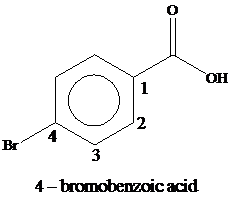
Concept explainers
PRACTICE PROBLEM 14.1
Provide a name for each of the following compounds.

Interpretation: The name is to be provided for each of the given compound.
Concept Introduction:
The substituent and the benzene ring together give a common accepted parent name.
The position is indicated by the numbers, if more than one group is present on the benzene ring.
Benzene ring with large substituents are named by treating benzene as a substituent. In such cases, benzene as a substituent is named as a phenyl group.
The benzene ring is numbered such that the substituent will get the lowest possible number.
Answer to Problem 1PP
Solution:
a)
b)
c)
d) Propoxybenzene
Explanation of Solution
(a)
Given information:

The compound contains a common structural unit of benzoic acid and bromine as a substituent is present at the fourth position. Thus, the name of the compound is

(b)
Given information:

The compound contains a simple derivative of benzene named as benzyl group. In cyclohexadiene, two double bonds are present at the first and the third position, and benzyl group is present at the second position. Hence, the name of the compound is

(c)
Given information:

This compound contains five carbon atoms in its longest continuous chain. The base name is pentane. The numbering is done in such a way that the substituent gets the lowest number. There are two substituents in this structure-chloro and phenyl group. Both chloro group and phenyl group are located at the second carbon atom. So, the name of the compound is

(d)
Given information:

The given compound contains ether as a functional group. The compound is named according to the groups bonded to the ether oxygen. The group bonded to the ether oxygen is phenyl and propyl. Hence, the name of the compound is Propoxybezene.

Want to see more full solutions like this?
Chapter 14 Solutions
Organic Chemistry
Additional Science Textbook Solutions
CHEMISTRY-TEXT
Living by Chemistry
Chemistry: The Molecular Nature of Matter
Chemistry: An Introduction to General, Organic, and Biological Chemistry (12th Edition) - Standalone book
Organic Chemistry As a Second Language: Second Semester Topics
Principles of Chemistry: A Molecular Approach (3rd Edition)
- A student was given from the list of the compounds below A, B and D blindly and asked to identify them all. He treated each of them with Brady's reagent (2,4-ditrophenylhydrazine) and isolated a bright yellow compound for one of them, but the other two gave false negatives. The student reasoned that the false negatives may be due to sterics and, on further thinking, it dawned on him that he might be able to rule out one of the false negatives with the haloform test. What compound did he find compatible with the haloform test? That compound did indeed give a false negative in the Brady test. Which of the other two was positive in the Brady test? A = haloform B = Brady A = haloform D = Brady B = haloform A = Brady B = haloform D = Brady D = haloform A = Brady D = haloform B = Bradyarrow_forwardProvide a mechanistic explanation for the following observation.arrow_forwardCompound A produce compound D while undergo Friedel Crafts Alkylation. Compound D is then oxidized and produce compound E (C11H12O3) as a major product.What are the possible structural formula of compound D and E?arrow_forward
- When the nitrogen-containing aromatic heterocyclic compounds 1 and 2 are treated with HCl, only 1 forms the hydrochloride salt, whereas compound 2 is unreactive. Provide an explanation for this observed reactivity.arrow_forwardGive the structure of compound 1 and compound 2arrow_forwardProvide a mechanism which explains the following conversions. Include all intermediates (where appropriate) and watch your arrows and chargesarrow_forward
- Bringing together your knowledge of the reaction chemistry of substituted benzenes, suggest a preparative route for conversion of compound A to compound B shown belowarrow_forwardGive the reagents and conditions necessary for the following conversion. A to B, B to D, B to C, B to E, E to F, E to G, G to H, H to I. Hence deduce the name and structural formula of the compounds C and I. Compare the procedure for converting F and E to G.arrow_forwardStarting with acid chloride with exactly 5 carbon atoms, and using appropriate reagents outline the synthesis of the following molecules:arrow_forward
- A certain compound is known to contain an aromatic benzene ring but failed to produce a fragrant yellow solution upon subjecting it to the nitration test. What may be a possible explanation for this? A. The benzene ring is part of a highly conjugated, blue dye molecule. B. The benzene ring contains a strong electron-withdrawing group. C. The benzene ring has no available sites left for electrophilic attack. D. All of the given. Kindly explain your answer in detail.arrow_forwardDiazepam, better known as Valium, is a central nervous system (CNS) sedative/ hypnotic. As a sedative, it diminishes activity and excitement and thereby has a calming effect. Back in 1976, based on the number of new and refilled prescriptions processed, diazepam was the most prescribed drug in the United States. Following is a retrosynthetic analysis for a synthesis of diazepam. Note that the formation of compound B involves a Friedel-Crafts acylation. In this reaction, it is necessary to protect the 2° amine by prior treatment with acetic anhydride. The acetyl-protecting group is then removed by treatment with aqueous NaOH followed by careful acidification with HCl. Q. Is diazepam chiral? If so, how many of the possible stereoisomers are formed in this synthesis?arrow_forwardDiazepam, better known as Valium, is a central nervous system (CNS) sedative/ hypnotic. As a sedative, it diminishes activity and excitement and thereby has a calming effect. Back in 1976, based on the number of new and refilled prescriptions processed, diazepam was the most prescribed drug in the United States. Following is a retrosynthetic analysis for a synthesis of diazepam. Note that the formation of compound B involves a Friedel-Crafts acylation. In this reaction, it is necessary to protect the 2° amine by prior treatment with acetic anhydride. The acetyl-protecting group is then removed by treatment with aqueous NaOH followed by careful acidification with HCl. Q.Given this retrosynthetic analysis, propose a synthesis for diazepamarrow_forward
 Organic ChemistryChemistryISBN:9781305580350Author:William H. Brown, Brent L. Iverson, Eric Anslyn, Christopher S. FootePublisher:Cengage Learning
Organic ChemistryChemistryISBN:9781305580350Author:William H. Brown, Brent L. Iverson, Eric Anslyn, Christopher S. FootePublisher:Cengage Learning
